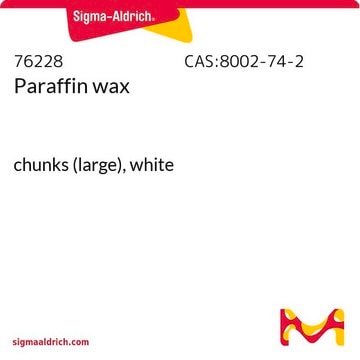327204
Paraffin wax
mp 53-58 °C (ASTM D 87)
Synonym(s):
Paraffin
Sign Into View Organizational & Contract Pricing
All Photos(1)
About This Item
Recommended Products
form
beads
waxy solid
mp
53-58 °C (ASTM D 87)
InChI key
JWHAUXFOSRPERK-UHFFFAOYSA-N
Looking for similar products? Visit Product Comparison Guide
Related Categories
General description
Paraffin Wax is a solidified microcrystal that is produced by continuous boiling of residual oils that include iso-alkanes. It is characterized in terms of soft and hard paraffins with a melting point in the range of 45-60°C.
Application
Paraffin wax can be used as a phase changing material (PCM) that can be loaded with exfoliated graphite nanoplatelets (xGnP) for the development of energy saving building materials. It may be used as a combustion material for hybrid rocket motor applications. Paraffin wax/graphite nanoparticles based nanocomposite may be used in the fabrication of hybrid storage material for solar still to desalinate seawater.
Storage Class
13 - Non Combustible Solids
wgk_germany
nwg
flash_point_f
602.6 °F - Pensky-Martens closed cup
flash_point_c
317 °C - Pensky-Martens closed cup
ppe
Eyeshields, Gloves, type N95 (US)
Certificates of Analysis (COA)
Search for Certificates of Analysis (COA) by entering the products Lot/Batch Number. Lot and Batch Numbers can be found on a product’s label following the words ‘Lot’ or ‘Batch’.
Already Own This Product?
Find documentation for the products that you have recently purchased in the Document Library.
Customers Also Viewed
Effect of asphaltenes on equilibrium and rheological properties of waxy model systems
Luis Alberto Alcazar-Vara, et al.
Fuel: The Science and Technology of Fuel and Energy, 93, 200-212 (2012)
<SMALL>Bancroft JD</SMALL>
Theory and Practice of Histotechnology null
Fabrication method of based-paraffin reconfigurable microfluidic chips using liquid dielectrophoresis and electrowetting transductions.
Renaudot R, et al.
Solid-State Sensors, Actuators and Microsystems, 2013 Transducers & Eurosensors XXVII: The 17th International Conference on. IEEE, 2013. (2013)
Paraffin products: properties, technologies, applications, 14 (1982)
Hybrid carbon nanotube yarn artificial muscle inspired by spider dragline silk.
Chun KY, et al.
Nature Communications, 5 (2014)
Our team of scientists has experience in all areas of research including Life Science, Material Science, Chemical Synthesis, Chromatography, Analytical and many others.
Contact Technical Service










